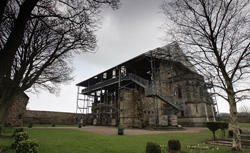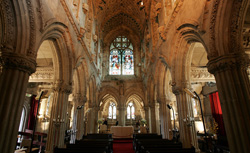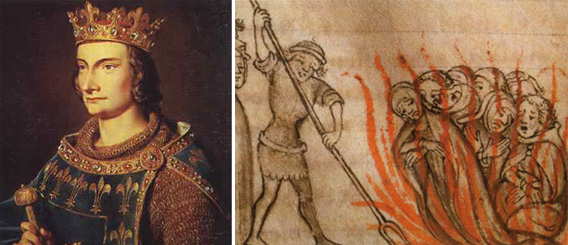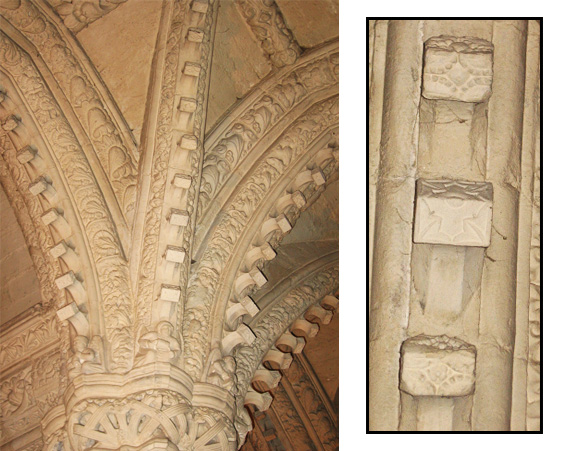The Rosslyn Code
The real mystery lurking in the chapel where Dan Brown set The Da Vinci Code.
From the outside, the Rosslyn Chapel does not look like a suitable place to hide Jesus' head. It's not much bigger than a country church, standing inconspicuously on a small hill in the miniature Scottish town of Roslin, a few miles south of Edinburgh. Its Gothic pinnacles, flying buttresses, and pointed arches have been battered by 500 years of capricious weather, and for years it has been encased in an exoskeleton of scaffolding as restoration efforts plod along. Until recently, it was covered by a giant black canopy.
But inside the chapel, beneath the carvings that blanket the walls and ceiling, is a spartan stone crypt that figures into one of history's most famous mythologies. According to legend, the treasure of the fabled Knights Templar is stowed in a still-deeper vault whose entrance is sealed off by a stone wall. Depending on whom you ask, that treasure is the Holy Grail, sacred scrolls from the time of Christ, a fragment of the cross on which he died, or even his embalmed head, secreted out of the Holy Land as the Templars fled prosecution 700 years ago.
If any of this sounds familiar, it's because Dan Brown borrowed this legend for The Da Vinci Code. In the book's climactic scene, the heroes race from London to Roslin, tailed by a hodgepodge group of French police and Catholic thugs. (At this point, they're on the brink of exposing a 2,000-year conspiracy to erase evidence that Christ had children.) They discover that the Holy Grail itself did once reside at Rosslyn, left there by the Templars so many centuries back, but has since vanished again.
The Da Vinci Code brought the Rosslyn Chapel to the world's attention. (Note: "Rosslyn" and "Roslin" derive from the same name, but by custom the chapel uses the former while the town and nearby castle use the latter.) While it had been popular among grail nerds and imaginative scholars for decades—Dan Brown didn't invent the Templar legend—the chapel was relatively obscure even in Scotland prior to the novel's 2003 debut. Tom Hanks and Audrey Tautou filmed the Rosslyn scene on location for the movie adaptation, further elevating its profile. Visits to the chapel increased by more than 50 percent, boosting revenue needed for the Rosslyn restoration project. (The chapel is still owned by descendants of its founder, Sir William St. Clair, but guided by a trust that oversees the site.)
You only need to spend a few minutes in the church to understand how it led to Dan Brown's flights of fancy. The Rosslyn Chapel is a conspiracy theorist's playroom, its interior a madhouse of mysterious stone carvings. In the movie version of The Da Vinci Code, Tom Hanks' professor of "symbology" stares reverently at the crowded walls. "Christian, Jewish, Egyptian, Masonic, Pagan," he says, ticking off the influences present in the place.
This isn't far off the mark, except for the Masonic part. (The chapel was completed more than a century before the founding of the Freemasons, though the order has retroactively claimed Rosslyn as part of its history.) The place is truly cluttered, like a person who's completely slathered with incongruous tattoos. Eight Nordic dragons form a ring around the base of one ornate pillar, while dozens of sylvan pagan deities known as Green Men peer out from the stone foliage. One arch depicts a richly detailed Danse Macabre, in which figures waltz with their future skeletons. A double-humped camel makes a curious appearance, even though such an animal was rare in Scotland at the time. Stories from both the New and Old Testament appear again and again.
Little documentation that might explain what the chapel's founders meant by all these carvings has survived. (Several fires at the nearby Roslin Castle consumed much of the St. Clair family's archives.) This lack of contradictory evidence is quite convenient for anyone who cares to theorize about the church's place in history. Rosslyn Chapel is a trove of mismatched puzzle pieces. The odds that you can find one to fit into whatever legend you're trying to sell are exceedingly high.

The Knights Templar were a real band of well-armored bankers, founded around 1120. The Knights' original detail was to protect pilgrims on their way to the Holy Land. But after the Egyptian sultan Saladin captured Jerusalem later that century, there wasn't much need for their services. No fewer than six crusades in the next 200 years would fail to establish a lasting Christian lease on the sacred territories. The Templars—reinterpreting their calling card as the "Poor Fellow-Soldiers of Christ and of the Temple of Solomon"—amassed great wealth and land, which was bestowed to them by European kings. By the early 14th century, they were in the lending business, charging healthy interest rates and milking their political ties to sidestep the church's ban on usury.
Without a large army to defend their great wealth, the knights became an easy target. In 1307, France's cash poor King Philip IV began a relentless campaign to round them up, culminating seven years later when the order's last grandmaster was burned at the stake. Most accounts end here, 150 years before the first stone was laid at Rosslyn Chapel. More creative historians, however, add an epilogue to the story: A handful of knights escaped persecution and fled to Scotland with the Templar treasure, finding succor under King Robert the Bruce—himself an exile from the church after he murdered a Scottish nobleman. Through various assimilations, the story goes, the Templars survived long enough to secret their sacred treasure to the Rosslyn Chapel, which was completed around 1480.
This is almost certainly untrue for a variety of reasons—it was nearly impossible, for example, to sail from northwest France to Scotland in the treacherous month of October, when the persecution began. But the association between Rosslyn and the grail remains unshakable, and the trust that oversees the chapel does little to correct the record, lest it run off conspiracy-minded tourists. (In addition to the usual run of T-shirts and mugs, the Rosslyn gift shop sells copies of The Da Vinci Code and a variety of other myth-mongering volumes.)
Like the chapel's crypt, Rosslyn's stone carvings are encrusted with dubious stories. One holds that a plant resembling maize, carved over an arch near the crypt, is proof that a Scotsman discovered the New World decades before Columbus and returned with this uniquely American crop. In reality, the cornhusks are probably bundled wheat, in keeping with the carvings' agrarian themes. But any sort of ambiguity is fuel for conspiracy theorists. Even the most outlandish story will persist so long as it meets two conditions: The theory has an ardent spokesman, and it's impossible to definitively disprove.
This is precisely why Tommy Mitchell is so easy to write off as bogus. His theory that there's a secret code hidden away in Rosslyn's stone carvings is outlandish, fantastical, and unfalsifiable. But after I spent a few days in Scotland scrutinizing his hypothesis, I found it increasingly difficult to be a skeptic.
The east end of Rosslyn Chapel sits under 13 crisscrossing arches that run the length of the room from north to south. While plenty of Gothic cathedrals feature a similar architectural flourish, the Rosslyn arches have a distinct feature: small sandstone cubes that protrude at regular intervals, like teeth. There are 213 cubes in all, 17 or 18 per arch. Each one bears a geometric pattern—a diamond, a rosette, an inverted circle. In all, 12 patterns repeat in irregular sequences, some appearing frequently, others just once or twice. At the base of each arch, save for the first and last, is an exquisitely carved stone angel either playing an instrument or singing from a hymnal.
Mitchell, a former cryptographer with the Royal Air Force, first stumbled upon the chapel nearly 40 years ago, when it was largely unknown and in disrepair. He would return to Rosslyn with increasing frequency over the years, always drawn to the cubes and their mysterious symbols. While there was no obvious order to the sequence of the cubes, Mitchell noticed that, as on a strand of DNA, little patterns would repeat. The same sequence of three symbols appears at the base of two of the arches, for instance, and one arch contains long stretches in which just one symbol is repeated.
Mitchell is certain this is no accident. The symbols, he believes, form a 500-year-old code bequeathed by the chapel's founders. And the angels are the key to deciphering it.

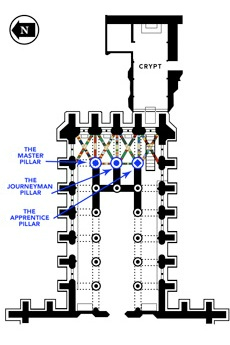
Continue to Part 2: Are the chapel's mysterious stone symbols a musical score?





